The best thing you can do is be prepared with both a disaster recovery plan and a business continuity plan.
The worst thing you can do is not have a plan for what to do when disaster strikes.
//
Your business faces challenges at every turn, from cybersecurity threats to natural disasters. The worst thing you can do is not have a plan for what to do when disaster strikes. And the best thing you can do is be prepared with both a disaster recovery plan and a business continuity plan.
Some people use the terms “disaster recovery” and “business continuity” interchangeably. The concepts are connected, so the misuse of these two terms is understandable. However, they’re not the same thing, and it can be risky to discuss them as if they are.
It’s important to understand the difference, that’s why we compiled this guide.
In this guide we’ll cover:
- What is disaster recovery?
- What is business continuity?
- Which is more important?Disaster recovery focuses primarily on preserving and managing data in the face of potential disasters such as human error, cyberattacks, hurricanes, floods, and power outages. It recognizes that even small bouts of downtime can add up to have a significant effect such as eroding customers’ trust in a company.
Key components of disaster recovery include continuous monitoring of essential systems and continuous data and system backups. A disaster recovery plan dives into acceptable levels of data loss, recovery times and prioritizing critical IT processes.
Smaller businesses may be able to tolerate more downtime, while just an hour’s downtime can be extremely expensive for a large company.



